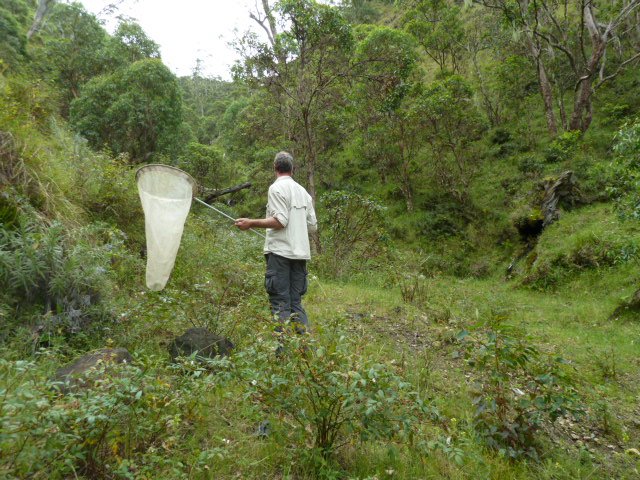The Act Of Butterfly Collecting (Timor-Leste Expedition)
Catching butterflies hasn't changed much in a hundred years: you still need a good net, keen eyes and quick reflexes. Entomologist Dr Dave Britton describes one of the amazing catches he made during the Museum's terrestrial expedition to Timor-Leste.

Timor-Leste Terrestrial Expedition #2
Image: Dave Britton© Australian Museum
Why is the Australian Museum in Timor-Leste? To assist with conservation planning and more.
The act of butterfly collecting is strongly associated in the public mind with Victorian well-to-do gentlemen and eccentric explorers visiting Borneo, the Amazon, and other remote jungle environments. So it often comes as a surprise that contemporary collectors are still using essentially the same methods as these characters.

Timor-Leste Terrestrial Expedition #54
Image: Jacquie Rescei© Australian Museum
The main prerequisites for collecting adult butterflies are: a net with a large opening and a long net handle, often with extensions to get those insects that perch high above the ground; good hand-eye coordination; and an eye for movement.
Along with this, experienced butterfly collectors have a natural ability to recognise different butterflies from even the most casual glimpse. The combination of behaviours, movement patterns and place in the natural environment provide instant cues. As with bird watchers, this ability can almost seem mystic to the observer. Bird watchers refer to this suite of characteristics as 'jizz', and each species has its own particular jizz.
As a result, when we stopped at an open trial forestry plot on the northern edge of Laclubar I immediately recognised the medium-sized butterfly with yellow under the wings flying around the tops of the small trees as a species from genus Delias (often called jezabels in Australia). There are not many species of East Timorese Delias and most are endemic and rare in collections. We certainly did not have any in the AM collections. This immediately got my blood flowing, and I was out of the vehicle in a rush.
A key ability was missing that day and my hand-eye coordination was lacking. I missed the first opportunity to net that specimen, and then missed another specimen which was perching on top of a small shrub. I was very aware that these butterflies are often only active for an hour or so each day, so each miss made it much more unlikely that I would ever get a specimen.
After yet another clumsy attempt I finally lost my temper. If I was a tennis player I would have been fined for net abuse, and the language was also probably in the same order. Through the red mist I saw that my fellow collectors were looking somewhat concerned, and eventually they calmed me down and got me to sit and eat some dry biscuits to try and get my blood sugar levels up.
No doubt some of the local people were also worried about my sanity, seeing a tall pale 'malae' (Tetum for foreigner) running through the undergrowth cursing and thrashing his net.
The butterflies appeared to have stopped flying, so I stalked through the low level weeds growing in the forestry plot, hoping to flush one from the foliage. It was looking grim when finally I saw a specimen fluttering around the top of a flowering bush. I held my breath, concentrated, swung and got it in the net bag. With trembling fingers I administered a neat pinch to the thorax to stun the insect and prevent it damaging its fragile wings against the net fabric. I then put it in a glassine triangle and into a killing jar.
It looked like a good specimen, although it had a small chip out of the edge of one forewing, but I was in no position to be fussy. The species was Delias splendida, aptly named because of the vivid yellow underside marked with black with a red dash. It is probably the most widespread of the East Timorese Delias, but by no means a common or easily caught butterfly.
The plot was at the top of a hill overlooking a mixture of village garden with some remnant native forest vegetation, so we spent more time collecting other insects, snails and invertebrates. An hour or so later we got back to the car, and I had a look at my precious specimen again. It was then that I flipped over the transparent triangle and noticed that the other underside of the specimen looked completely different to the side I had just looked at.
The implications finally sunk in – the specimen was a gynandromorph. Gynandromorphy occurs when organisms which normally have separate male and female sexes produce individuals which have elements of both male and female morphology. In butterflies it is extremely rare, with estimates of occurrence in natural populations ranging between 1 in 28,000 to 1 in 500,000 individuals.
It can be a mosaic of characters, such as having one wing which has traces of male colouration in an otherwise female butterfly, or it can be bilateral as in the case of this specimen of Delias splendida from Timor-Leste, which is half male on one side and female on the other.
Because gynandromorphs are so rare they are objects of desire for many collectors, and some specimens reach very large sums on the open market. This specimen, however, will remain in the Australian Museum for future visitors to the collection to marvel at.

